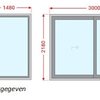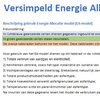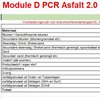Product Category Rules
The Environmental Performance of Construction Works Assessment Method (Assessment Method), along with EN 15804 and the underlying standards, provides the rules for compiling an LCA in the framework of the National Environmental Database (NMD). It is becoming increasingly clear that supplementary rules per product category are desirable. These supplementary rules are also called complementary Product Category Rules (c-PCRs).

c-PCRs are a collection of specific rules, requirements and guidelines for drawing up Environmental Product Declarations (EPDs) for one or more product categories. They are used to supplement the programme instructions, for example calculation rules, scenarios and EPD content. c-PCRs help LCA practitioners generate consistent results in the assessment of products of the same product category. ISO 14025:2010 describes the procedure for developing and testing c-PCRs and sets requirements for the comparability of different EPDs.
Internationally and nationally, there are many c-PCR (type) documents, with a variety of publishers/controllers. In view of the importance, the use of PCRs from the Assessment Method has been made compulsory. However, the Assessment Method does not include a provision relating to the c-PCR documents, merely a reference to this page.
Normative c-PCRs
The Assessment Method refers to the website of Stichting NMD for the current overview of normative c-PCRs. This overview is shown below and distinguishes between European normative c-PCRs and Dutch normative c-PCRs designated by Stichting NMD.
Read the news item: Normativity of PCRs within the NMD system
Click to read more information about the relevant PCR.
PCR Asphalt V2.0
Standard: Dutch elaboration
Status: normative
Read the news item about PCR Asphalt V2.0
View appendices D and E of the PCR Asphalt
PCR Cement V1.0
Standard: Dutch elaboration
Status: normative
PCR Cement and building lime
Standard: EN16908/A1
Status: normative
PCR Building Hardware
Standard: EN17610
Status: normative
PCR Windows and Doors
Standard: Dutch elaboration
Status: Entry into force 1 July 2025
PCR Thermal insulation products
Standard: EN16783
Status: Entry into force 1 July 2025
PCR Fibre Optic Network Components
PCR Fibre Optic Network for Active and Passive Components
Standard: Dutch supplement
Status: Effective as of 1 January 2026
- PCR active fiber optical network components March 2025
- PCR passive fiber optical network components March 2025
Overview of European PCRs
Stichting NMD maintains an overview of European PCRs (including those under development). The overview highlights in green the European PCRs that must be followed when preparing an LCA in accordance with the Assessment Method. Initiatives for standard development within CEN/TC 350/WG 3 are shown in orange for informational purposes.
Drafting a Dutch c-PCR
At the initiative of the market, a new c-PCR can be developed for a specific product group. Stichting NMD has developed a Protocol for drafting and managing a c-PCR. This protocol provides guidance to the initiator and clarity from Stichting NMD on the criteria for recognising c-PCRs as applicable. It also ensures consistency within and between c-PCRs for different material and product groups.
Downloads
Read more




Altijd actueel:
nieuws over duurzaam bouwen en milieuprestatie & milieudata
Ontvang elke maand het laatste nieuws duurzaam bouwen, milieuprestatie,
milieudata, inclusief tips en voorbeelden uit de praktijk.







